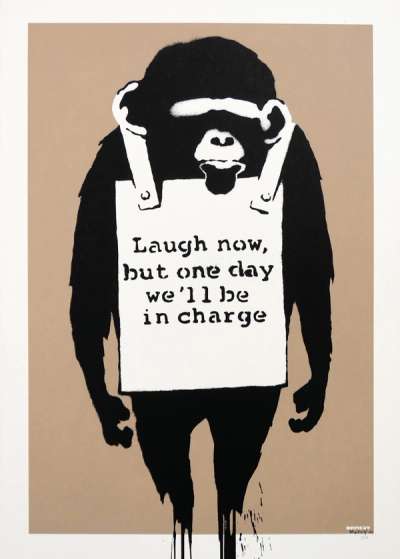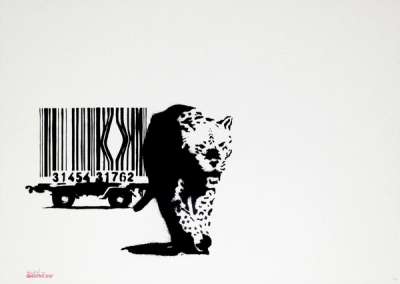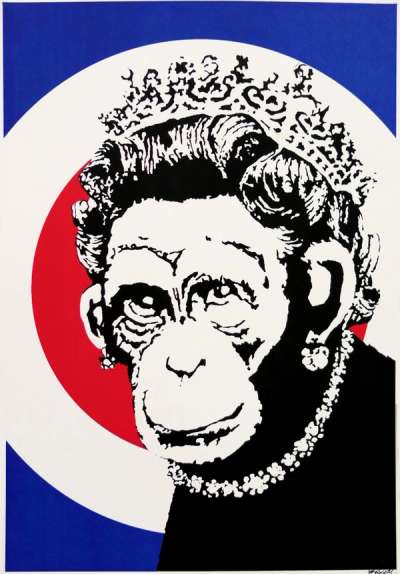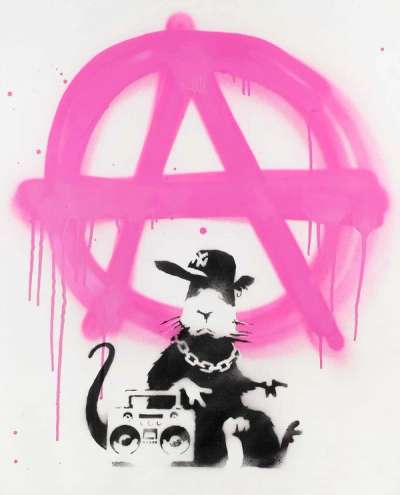Banksy's Monkey Poison

 Monkey Poison © Banksy 2004
Monkey Poison © Banksy 2004
Banksy
268 works
Banksy’s anonymity has made him an enigmatic figure in the world of contemporary art – one that has consistently utilised his art as a medium for social commentary, blending dark humour with profound messages on global issues. Monkey Poison epitomises the evolution of his artistic practice, showcasing his adeptness at combining wit with weighty commentary. This piece, a part of the Vandalised Oils series, reflects a critical point in Banksy's career, where his work transitioned from street art to globally recognised pieces that command attention both on the streets and in auction houses.
Monkey Poison: Meaning & Analysis
At the heart of Monkey Poison lies a compelling narrative on environmental degradation and the ethical implications of humanity's over-consumption habits. By juxtaposing the innocence of a monkey with the hazardous act of drinking gasoline, Banksy starkly highlights the unintended consequences of industrial progress. This piece serves as a microcosm of the broader environmental crises facing the planet, from climate change to habitat destruction, urging viewers to contemplate their role in these issues.
Banksy's choice of medium—spray paint on a found oil painting—embodies a fusion of traditional art with contemporary street art, challenging conventional notions of what constitutes high art. This approach not only democratises creativity, making it accessible outside the confines of galleries and museums but also questions the value systems that govern the art world. Monkey Poison, with its disruptive imagery superimposed on a pastoral scene, exemplifies Banksy's skill in creating visual paradoxes that invite reflection and debate. Thus, it transcends the boundaries of art to become a catalyst for public discourse on pressing global issues. Banksy's work has the unique ability to engage a wide audience, sparking conversations among those who might not typically engage with environmental or humanitarian activism. The visceral impact of the monkey's oblivious consumption of toxic substances serves as a powerful metaphor for society's often unthinking participation in practices that harm the environment, making the message widely accessible and impactful.
“Monkey Poison exemplifies Banksy's ability to intertwine sharp social critique with dark humour. By disrupting a traditional pastoral scene, he challenges viewers to consider our role in the ongoing environmental crisis.”

The Role of Art in Social Commentary
Monkey Poison is not an isolated commentary but part of Banksy's broader Vandalised Oils series, which collectively critiques various facets of modern life, from consumerism to war. By inserting disruptive elements into otherwise tranquil and traditional scenes, Banksy forces viewers to confront uncomfortable truths about the contemporary world. This series challenges viewers to see beyond the surface, encouraging a deeper engagement with the artwork and the issues it represents. It exemplifies the role of art in serving as a mirror to society, reflecting back the complexities and contradictions of contemporary life. Art, in Banksy's hands, becomes a tool for awareness, dialogue, and potential change, demonstrating its power to influence public opinion and inspire action. In this sense, Monkey Poison and similar works contribute to a broader understanding of art's potential to address critical global issues.
The environmental themes explored in this work are increasingly relevant in today's world, where the impacts of climate change and ecological destruction are felt more acutely with each passing year. Banksy's work is part of a growing artistic movement that seeks to highlight these issues, using the universal language of art to communicate the urgency of environmental activism. Through pieces like this, artists can play a pivotal role in mobilising public sentiment and fostering a collective response to environmental challenges.
As such, Monkey Poison stands as a testament to Banksy's ingenuity and commitment to blending art with activism. This piece not only showcases Banksy's distinctive style and skillful use of visual metaphor but also encapsulates a profound message about the impact of human actions on the environment. Through this work, Banksy challenges viewers to reconsider their relationship with the natural world and the legacy of their consumption habits. As a pivotal work within Banksy's oeuvre and the broader canvas of contemporary art, it underscores the critical role of art in sparking dialogue, challenging societal norms, and inspiring change. Through works such as this, we are reminded of the power of art to not only capture the imagination but also to encourage action towards a more sustainable and ethical future.












